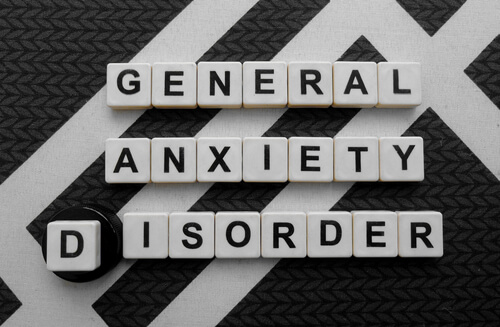
It is natural to feel anxious, concerned, or even a minimal amount of fear when faced with a significant life event. Millions of people worldwide struggle with natural symptoms of anxiety before taking a test, making an important decision, facing difficulties at work, or even as a precursor to happy events such as getting married or having your first child. Anxiety is a natural human reaction to events that allows us to make last-minute “fight or flight” decisions if necessary. On the other hand, anxiety disorders involve more than natural reactions such as temporary fear or worries. When you struggle with an anxiety disorder, the fear and worry do not naturally alleviate upon completion or termination of an event. Concerns and worries linger and often get worse over time. Eventually, anxiety can interfere with daily activities, including employment, academic performance, and personal relationships.
What is Anxiety?
Anxiety is the body’s natural response to stress, worry, or fear. It is the feeling of concern or apprehension about what may happen or what could happen. For teens, first dates, the first day of high school, starting a new school, or events such as graduation, prom, or applying to college can all bring about feelings of anxiety. Again, these are normal reactions to life events. But if feelings of anxiety are extreme or last for longer than six months and interfere with your teen’s day-to-day functioning, they may have an anxiety disorder that could benefit from treatment in a teen-focused environment such as Beachside.
What is an Anxiety Disorder?
“Ordinary anxiety,” or the anxiety that many of us experience on occasion is normal. In many cases, it motivates us to do better or work harder. However, unlike ordinary anxiety that comes to goes, anxiety disorders lead to feelings of fear and worry that are with us all the time. For some, these emotions because overwhelming and even debilitating. The anxiety that stems from an anxiety disorder may lead your teen to stop doing the things they enjoy. In other cases, it may inhibit their ability to complete day-to-day functions, including things we often view as simple such as crossing the street, ordering a cup of coffee, or leaving their house. Left untreated, the anxiety that arises from an anxiety disorder will get worse.
Types of Anxiety Disorders
Depending on the source of information, and the level to which categories are broken down, there are anywhere between five and eleven major types of anxiety disorders. The United States Department of Health and Human Services lists five major categories of anxiety disorder.
Generalized Anxiety Disorder
Generalized anxiety disorder is a category of anxiety characterized by persistent and excessive worry about many different things. A teen with a generalized anxiety disorder may be overly concerned about their health, school, relationships or focus their concerns on the potential for impending disaster. Someone with a generalized anxiety disorder will find it difficult to control their worry. They may worry more than would be considered necessary about actual events or expect the worst even when there’s no apparent need for concern.
Obsessive-Compulsive Disorder (OCD)
Obsessive-compulsive disorder or OCD is a form of anxiety that many are familiar with. OCD is characterized by recurrent, unwanted thoughts (referred to as obsessions) and repetitive behaviors (called compulsions). Repetitive behaviors such as hand washing, checking, cleaning, counting, and others are performed in the hope of preventing obsessive thoughts or making the thoughts go away. For someone who struggles with OCD, performing these behaviors or “rituals” often provides only minimal and temporary relief; however, not performing them significantly increases feelings of anxiety and fear.
Panic Disorder
Panic disorders are characterized by repeated and typically unexpected episodes of overwhelming fear. Fear is generally accompanied by physical symptoms, including heart palpitations, shortness of breath, stomach upset, chest pains, and sometimes dizziness. These “panic attacks” sometimes occur for unknown reasons and without provocation. Someone who struggles with a panic disorder often lives in fear of when the next panic attack will occur.
Post-Traumatic Stress Disorder (PTSD)
Post-traumatic stress disorder or PTSD is another category of anxiety disorder many people have some understanding of. PTSD is a type of anxiety disorder that can develop after exposure to an event or situation where significant trauma was threatened or occurred. Many people associate PTSD with members of the military returning from active-duty deployments; however, it can impact anyone and for many reasons other than actively serving on the front lines. Members of emergency medical services, doctors, nurses, law enforcement, and even “ordinary citizens” who have been exposed to trauma can struggle with post-traumatic stress disorder. Events that can lead to PTSD include natural or human-caused disasters, accidents, sexual assaults, or other violent crime types.
Social Phobias (Social Anxiety Disorder)
Social phobias, sometimes referred to as social anxiety disorders are anxiety that stems from everyday social situations. A teen who struggles with a social anxiety disorder will experience overwhelming anxiety and excessive self-consciousness when placed in a social setting. Depending on the individual nature of one’s symptoms, a social phobia can be limited to only one type of situation, such as a fear of public speaking or eating and drinking in front of others, or it can be more severe. In its most severe form, anxiety in social situations can be so overwhelming that a person experiences symptoms anytime they are around other people. People don’t need to be strangers for a teen to experience social anxiety in a social setting. With social phobias, fear and apprehension can occur when surrounded by friends and family equally as often as when surrounded by strangers.
Other Common Anxiety Disorders
Although the categories mentioned above of anxiety disorder are some of the most common and most well-known, there are other forms of anxiety disorder people struggle with each day.
Illness Anxiety Disorder
Illness anxiety disorder formally referred to as hypochondria, is a chronic fear or worry about one’s health. It is characterized by an overwhelming fear of potential sickness or illness even if current circumstances do not indicate the need for worry. Someone who struggles with an illness anxiety disorder will live in constant fear of getting sick, being sick, or losing their lives to disease or illness. They will often search “symptoms” online to see if a feeling or symptoms they have is indicative of disease or illness. Often, people with an illness anxiety disorder will spend significant time in and out of medical settings attempting to diagnose disease-related conditions that may or may not exist.
Separation Anxiety Disorder
Separation anxiety disorder is a type of anxiety disorder characterized by feelings of fear or worries about being apart from family members or loved ones. A teen who struggles with a separation anxiety disorder may fear being separated from their family or something terrible occurring to the family member if they are not close to them. In many cases, the longer they are separated from family or loved ones, the worse their symptoms will become.
Agoraphobia
Someone who struggles with agoraphobia will experience overwhelming fear or worry when they believe their environment is unsafe or that they could not easily escape. These situations can include open spaces such as shopping centers, public transport, or simply being in a setting away from their home. Being in these environments may lead to panic attacks and often occur every time this situation is encountered. A teen who struggles with agoraphobia will go to great lengths to avoid being placed in these situations and, in some cases, may become completely unable to leave their home.
What Causes Anxiety Disorders?
It is believed that both environmental and genetic factors may contribute to the risk of developing anxiety disorders. Although the risk for developing each category of anxiety disorder can vary, there are various “general” risk factors for all types of anxiety disorders. These can include exposure to stressful and negative events in early childhood, a history of mental illness and biological relatives, a history of anxiety disorders in biological relatives, and certain childhood traits such as shyness or behavioral inhibitions. It is important to note that certain physical health conditions can produce or aggravate anxiety symptoms. Hence, a physical health examination by your team’s primary care provider is vital when evaluating the possibility of an anxiety disorder.
Treating Anxiety Disorders
Anxiety disorders, regardless of type, are typically treated using a combination of psychotherapy and medication. There are many successful treatment models for anxiety disorders, and it is important to work with your teen’s mental health practitioner at Beachside to choose the treatment course that is best for them.
Psychotherapy or “talk therapy” is a proven treatment model to help people with anxiety disorders. The most effective therapies are directed at the person’s specific anxieties and tailored to meet their unique treatment needs and goals. Cognitive-behavioral therapy or CBT is an example of one type of psychotherapy proven successful in treating many anxiety disorders. The purpose of CBT is to encourage your teen to consider the causes of their anxieties and related actions or behaviors and analyze why they occur. After they gain a better understanding of the root causes of their fears, it is possible to learn healthy, safer ways to manage their symptoms.
Exposure therapy (a form of cognitive therapy) is often used together or on its own to help treat anxiety disorders. Exposure therapy focuses odd confronting fears at the root of an anxiety disorder to help those who struggle with anxiety engage in the activities and experiences they have actively avoided. Exposure therapy is sometimes used along with relaxation exercises, imagery practice, and forms of psychotherapy to help create a comprehensive treatment model.
Medication is not meant to cure anxiety disorders; however, it can help reduce the intensity of symptoms during the therapeutic process. Anti-anxiety medications can help reduce the symptoms of anxiety, extreme fear, and panic attacks. The most common anti-anxiety medications are benzodiazepines. Because of the potential side effects of benzodiazepine use, they are often prescribed for short periods or on an as-needed basis after a comprehensive treatment program is complete.
Antidepressants can also help treat certain anxiety disorders. They work to help improve the way the brain uses chemicals that control mood and stress. It may be necessary for your teen to try several antidepressant medications before finding the one that improves their symptoms best while producing the least amount of side effects.
Anxiety disorders are more common among adolescents and teens than many realize. According to data provided by the National Survey of Children’s Health (NSCH), as many as 9.4% of children between the ages of three and seventeen years (approximately 5.8 million individuals) have received a diagnosis of anxiety problems, with prevalence increasing with age. Of those, the highest rates occur in teens ages twelve to seventeen. Unfortunately, many teens do not understand or want to discuss their symptoms. Therefore, they live with day-to-day anxiety until the emotions become overwhelming and debilitating.
It’s important to note that anxiety disorders are highly treatable. Even in the most severe cases, a comprehensive, evidence-based psychotherapy program at Beachside can help your teen overcome anxiety symptoms. If you are concerned that your teen is struggling with anxiety, reach out to our admissions team today to learn more about how our teen-focused treatment programs can help them on their journey to a healthy, happy life.
https://adaa.org/understanding-anxiety/generalized-anxiety-disorder-gad




